Each of the euro area countries uses familiar or traditional motifs and icons for the design of the national sides of their coins. Some countries have a different design for each denomination of coin; others apply the same design to everything.
You can see an overview of all euro coins of other EU member states on the websites of the European Central Bank and the European Commission.
| ANDORRA | |
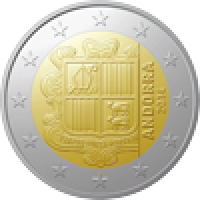 |
The €2 coin shows the coat of arms of Andorra with the motto "virtus unita fortior" (virtue united is stronger). Edge lettering of the €2 coin: 2 **, repeated six times. The €1 coin features Casa de la Vall, a building of cultural and historical interest, the former seat of parliament. The 10, 20 and 50 cent coins show the Romanesque church of Santa Coloma. The 1, 2 and 5 cent coins show a Pyrenean chamois and a golden eagle. |
| AUSTRIA | |
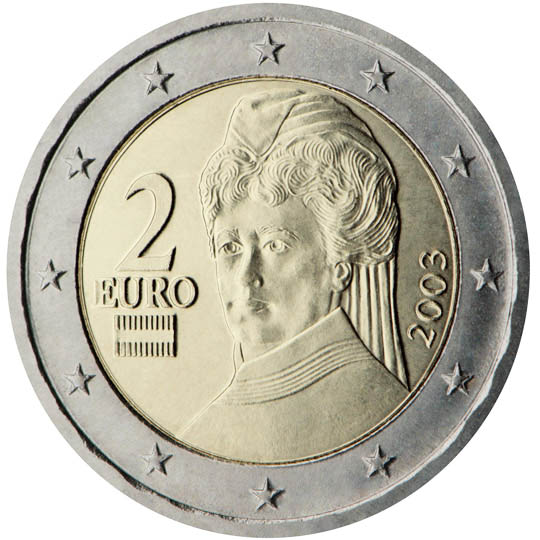 |
Edge lettering of the €2 coin: 2 EURO ***, repeated four times, alternately upright and inverted. The €2 coin bears a portrait of the pacifist Bertha von Suttner, a symbol of Austria's efforts over many decades to support peace. Depicted on the €1 coin is Wolfgang Amadeus Mozart, the famous Austrian composer. The 50 cent coin shows the secession building in Vienna, illustrating the birth of art nouveau in Austria. The building symbolises the birth of a new age and represents a bridge to a new monetary era. The 20 cent coin features the motif of the Belvedere Palace in Vienna. It was here that the treaty re-establishing the sovereignty of Austria was signed in 1955, making its name synonymous with freedom. The 10 cent coin depicts St. Stephen’s Cathedral, one of the jewels of Viennese Gothic architecture and a popular tourist venue. The 5 cent coin features alpine primroses, as part of a floral series, symbolising a duty to the environment and the part Austria is playing in the development of a Community environmental policy. The 2 cent coin features an edelweiss, as part of a floral series, symbolising a duty to the environment and the part Austria is playing in the development of a Community environmental policy. The 1 cent coin features a gentian, as part of a floral series, symbolising a duty to the environment and the part Austria is playing in the development of a Community environmental policy. Design by: Josef Kaiser |
| BELGIUM | |
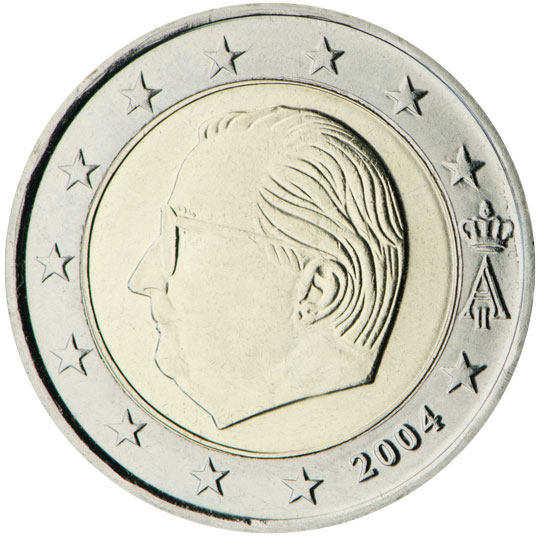 |
There are three series of Belgian coins in circulation. All are valid. The first series Edge lettering of the €2 coin: 2 **, repeated six times, alternately upright and inverted. Design by: Jan Keustersmans |
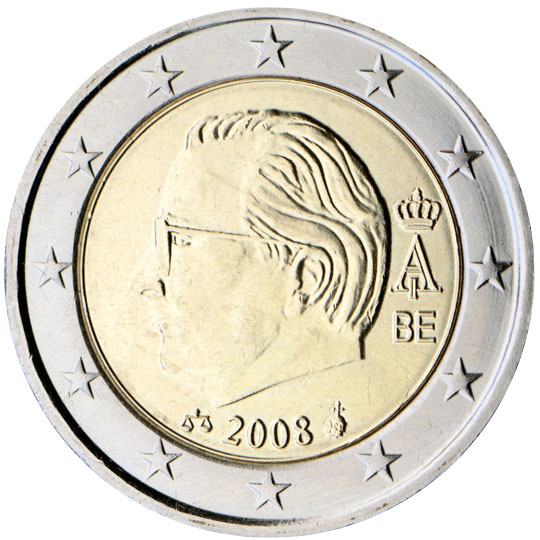 |
The second series Edge lettering of the €2 coin: 2 **, repeated six times, alternately upright and inverted. Design by: Jan Keustersmans |
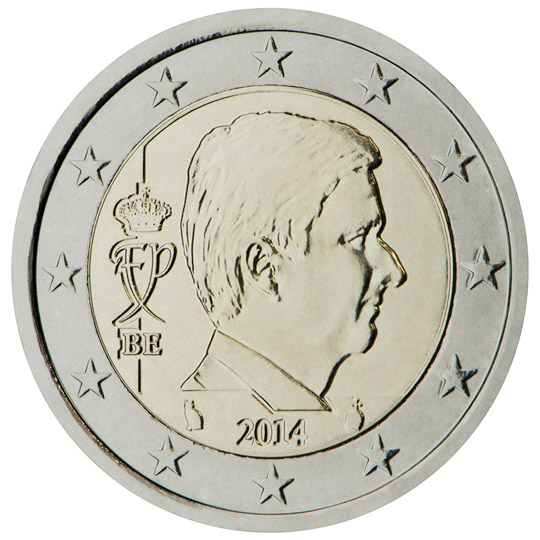 |
The third series NEdge lettering of the €2 coin: 2 **, repeated six times, alternately upright and inverted. ADesign by: Luc Luycx |
| CYPRUS | |
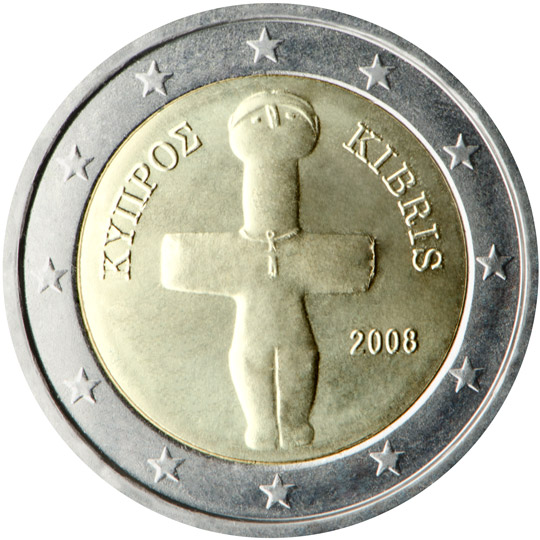 |
The €1 and €2 coins depict a part of prehistoric art, a cruciform idol from the Chalcolithic period (3000 BC) reflecting Cyprus's place at the heart of civilisation and antiquity. Featured on the 10, 20 and 50 cent coins is the Kyrenia ship, a trading vessel which dates back to the 4th century BC and a symbol of Cyprus's seafaring history and its importance as a centre of trade. The 1, 2 and 5 cent coins show the moufflon, a species of wild sheep found on Cyprus and representative of the island's wildlife. Design by: Tatiana Soteropoulos and Erik Maell |
| ESTONIA | |
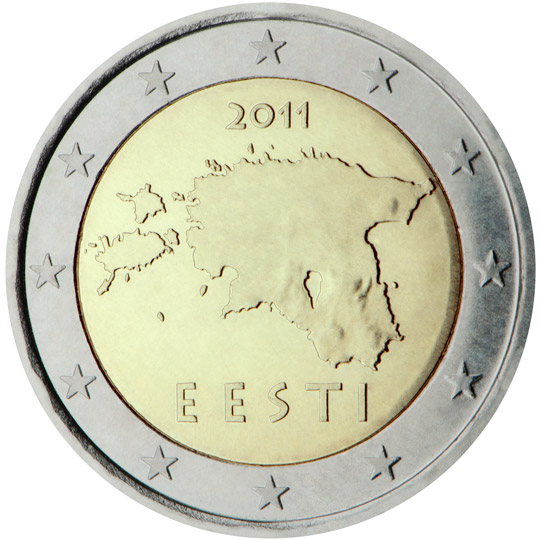 |
The design for the national side of Estonia’s euro coins is the same for all denominations. It features a geographical image of Estonia and the word "Eesti", which means "Estonia” in the Estonian language. Design by: Lembit Lõhmus |
| FINLAND | |
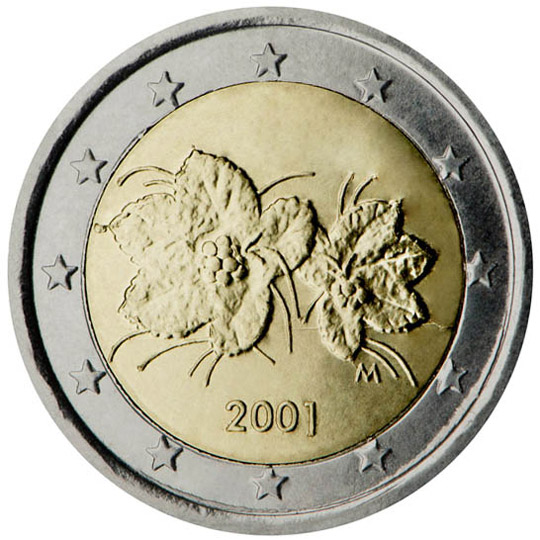 |
The motif on the €2 coin comprises cloudberries and cloudberry flowers. Edge lettering of the €2 coin: SUOMI FINLAND ***, where the * represents a lion's head. The €1 coin features a motif depicting two flying swans. 1, 2, 5, 10, 20 and 50 cent coins show the Finnish heraldic lion. The heraldic lion has been used as a motif in a variety of issues of Finnish coins over the years. |
| FRANCE | |
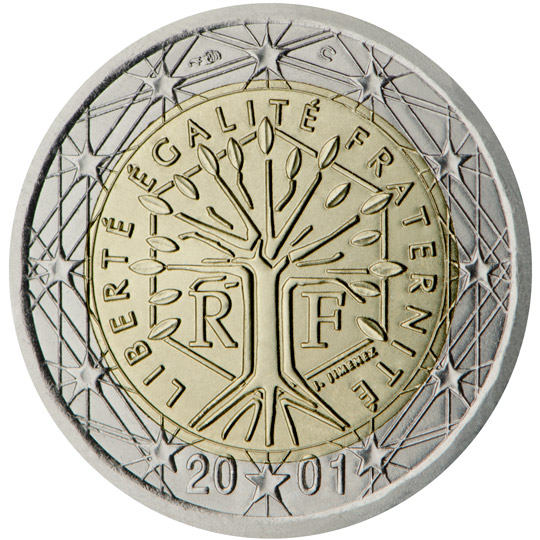 |
There are two series of French coins in circulation. All are valid. The first series Edge lettering of the €2 coin: 2**, repeated six times, alternately upright and inverted. The 10, 20 and 50 cent coins feature a sower, the motif from the history of the French franc representing France, which stays true to itself, whilst integrating into Europe. The 1, 2 and 5 cent coins depict a young, feminine Marianne with determined features that embody the desire for a sound and lasting Europe. |
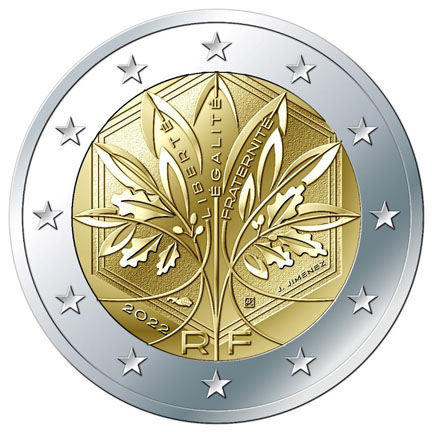 |
The second series Edge lettering of the €2 coin: 2**, repeated six times, alternately upright and inverted. |
| GERMANY | |
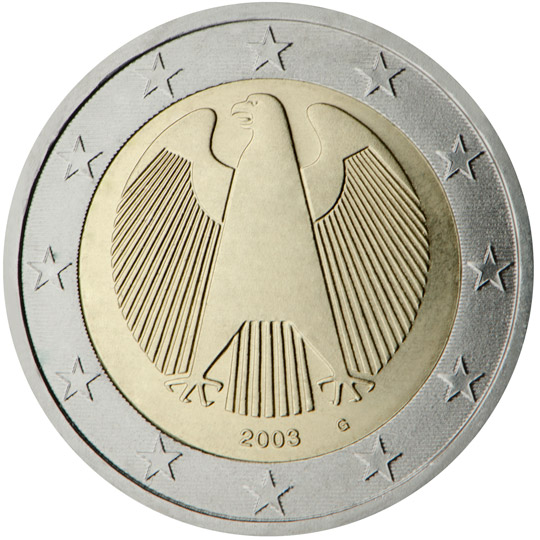 |
The €1 and €2 coins show the eagle, the traditional symbol of German sovereignty. Edge lettering of the €2 coin: EINIGKEIT UND RECHT UND FREIHEIT (unity, justice and freedom) and the emblem of the Federal Eagle. The Brandenburg Gate, a symbol of the division of Germany and its subsequent reunification is the motif used on the 10, 20 and 50 cent coins. The oak twig, reminiscent of that found on the former German pfennig coins, provides the motif for the 1, 2 and 5 cent coins. Design by: Heinz Hoyer and Sneschana Russewa-Hoyer (€1 and €2), Reinhart Heinsdorff (10, 20 and 50 cent), Rolf Lederbogen (1, 2 and 5 cent) |
| GREECE | |
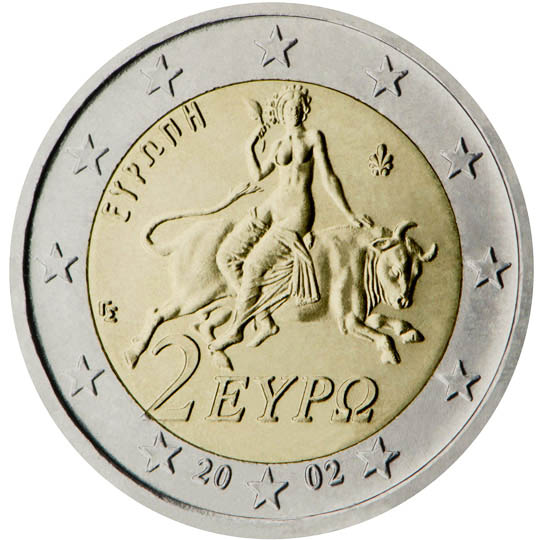 |
The €2 coin depicts a scene from a mosaic in Sparta (3rd century AD), showing Europa being abducted by Zeus, who has taken the form of a bull. Europa is a figure from Greek mythology after whom Europe was named. Edge lettering of the €2 coin: EΛΛHNIKH ΔHMOKPATIA * (Hellenic Republic). The €1 coin features the motif of the owl and was copied from an ancient Athenian 4-drachma coin (5th century BC). A portrait of Eleftherios Venizelos (1864 – 1936), one of Greece's most prominent political figures, is shown on the 50 cent coin. He was a pioneer in social reform, a renowned diplomat and played a key role in modernising the Greek state and liberating Northern Greece and the Aegean islands. The 20 cent coin features a portrait of Ioannis Capodistrias (1776 – 1831), a leading national and European politician and diplomat who became the first Governor of Greece (1830 – 1831) following the Greek War of Independence (1821 – 1827). The 10 cent coin features a portrait of Rigas Fereos (Velestinlis) (1757 – 1798), a forerunner and leading figure of the Greek enlightenment, a visionary and herald of Balkan liberation from Ottoman rule. The 5 cent coin shows a modern sea-going tanker, reflecting the innovative spirit of Greek shipping. The 2 cent coin depicts a corvette (a ship) used during the Greek War of Independence (1821 – 1827). The 1 cent coin features an advanced model of an Athenian trireme, the largest warship afloat for more than 200 years, dating from the time of the Athenian democracy (5th century BC). Design by: Georges Stamatopoulos |
| IRELAND | |
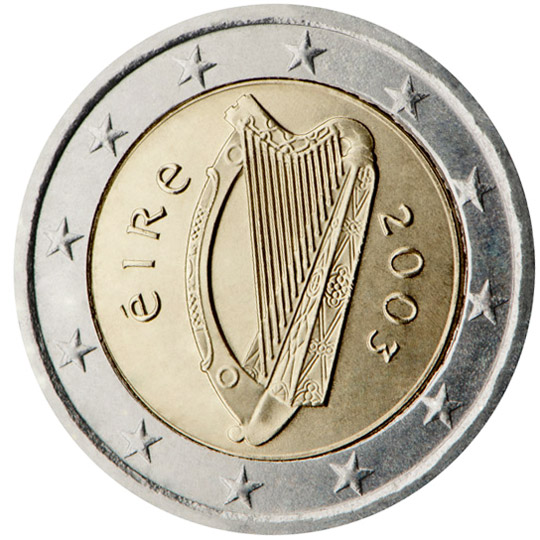 |
All coins feature a single national design, showing the motif of the Celtic harp, a traditional symbol of Ireland. The motif of the Celtic harp is encircled by the year of issue and the inscription “Éire”, the Irish word for Ireland. Edge lettering of the €2 coin: 2**, repeated six times, alternately upright and inverted. Design by: Jarlath Hayes |
| ITALY | |
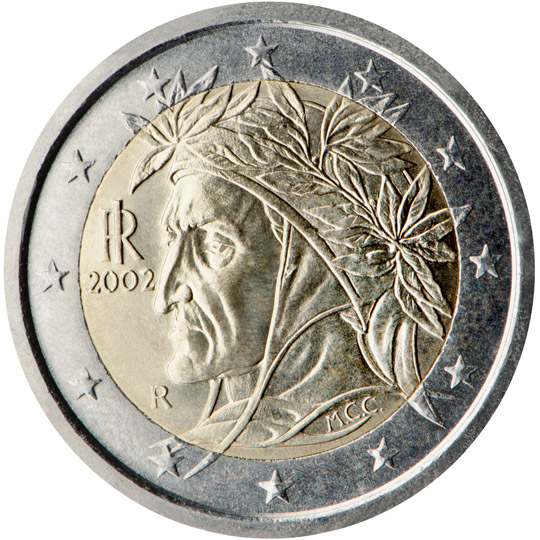 |
The €2 coin depicts a portrait drawn by Raphaël of Dante Alighieri, housed in the Pope Julius II Wing of the Vatican City Palace. Edge lettering of the €2 coin: 2*, repeated six times, alternately upright and inverted. The €1 coin shows the famous drawing by Leonardo da Vinci, displayed in the Gallery of the Academy in Venice, illustrating the ideal proportions of the human body. The 50 cent coin features the motif of the statue of Emperor Marcus Aurelius on horseback. Portrayed on the 20 cent coin is the motif of a sculpture by Umberto Boccioni, leader of the Italian futurist school. The 10 cent coin shows one of the most famous works in the world, the “Birth of Venus” by Sandro Botticelli. The 5 cent coin features the Flavius amphitheatre, which Emperor Vespasian began building around 75 AD and Emperor Titus inaugurated in 80 AD. The 2 cent coin shows the Mole Antonelliana, a tower designed in 1863 by the architect Alessandro Antonelli. The motif of the Castel del Monte appears on the 1 cent coin. Design by: Eugenio Driutti (1 cent), Luciana De Simoni (2 cent), Ettore Lorenzo Frapiccini (5 cent), Claudia Momoni (10 cent), Maria Angela Cassol (20 cent), Roberto Mauri (50 cent), Laura Cretara (€1), Maria Carmela Colaneri (€2) |
| LATVIA | |
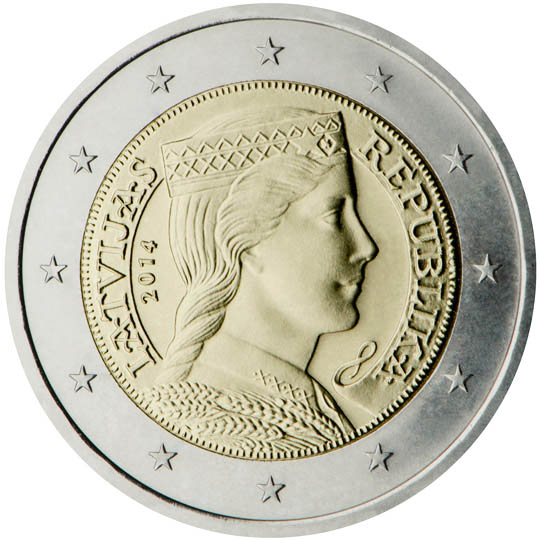 |
The €1 and €2 coins feature a Latvian folk maiden. This image was originally used on the silver 5 lats coin in 1929. The edge of the coin bears the inscription DIEVS * SVĒTĪ * LATVIJU (GOD BLESS LATVIA). The 10, 20 and 50 cent coins show the large coat of arms of the Republic of Latvia. The 2, 1 and 5 cent coins show the small coat of arms of the Republic of Latvia. The design of the €1 and €2 coins is by Guntars Sietiņš, and the design of the cent is by Laimonis Šēnbergs. |
| LITHUANIA | |
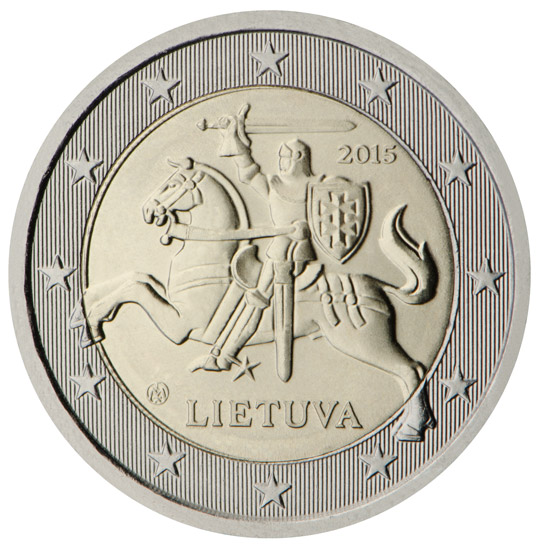 |
All the denominations of Lithuanian coins show the coat of arms of the Republic of Lithuania, Vytis, the inscription “LIETUVA” and the year of issuance. Edge lettering of the €2 coin: LAISVĖ * VIENYBĖ * GEROVĖ * (Freedom * Unity * Well-Being *) Design by: Antanas Žukauskas |
| LUXEMBOURG | |
 |
All the denominations of the Luxembourgian euro coins bear the portrait of His Royal Highness Grand Duke Henri. They also bear the year of issue and the word “Lëtzebuerg”, the name for Luxembourg written in Luxembourgish. Design by: Yvette Gastauer-Claire |
| MALTA | |
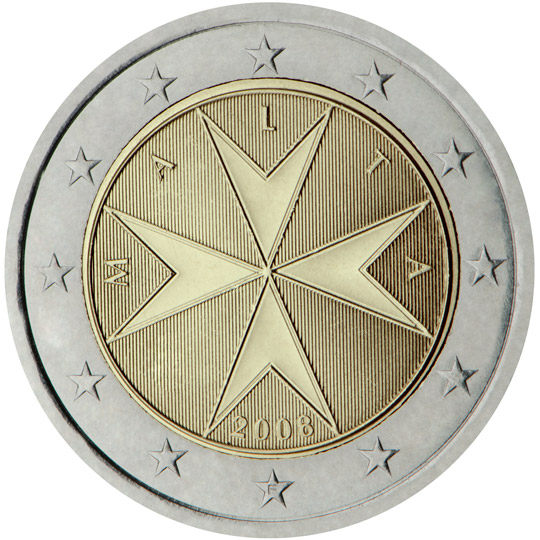 |
The €1 and €2 coins show the emblem used by the Sovereign Order of Malta. During the Order's rule over Malta, between 1530 and 1798, the eight-pointed cross became associated with the island and is now often referred to as the Maltese Cross. The 10, 20 and 50 cent coins bear the Emblem of Malta, a shield displaying a heraldic representation of the Maltese national flag and supporting a mural crown that represents the fortifications of Malta and denotes a city state. The shield is bounded on the left by an olive branch and on the right by a palm branch, the symbols of peace traditionally associated with Malta, forming a wreath tied at its base by a ribbon which carries the inscription "Repubblika ta' Malta" (Republic of Malta). The 1, 2 and 5 cent coins depict the altar at the prehistoric temple complex of Mnajdra, built around 3600 BC on a low elevation overlooking the sea. Design by: Noel Galea Bason |
| MONACO | |
 |
There are two series of Monegasque coins in circulation. All are valid. The first series Edge lettering of the €2 coin: 2**, repeated six times, alternately upright and inverted. A double portrait of HSH Prince Rainier III and HSH Hereditary Prince Albert appears on the €1 coin. HSH Prince Albert’s monogram is depicted on the 10, 20 and 50 cent coins. The coat of arms of the Sovereign Princes of Monaco is the main feature of the design on the 1, 2 and 5 cent coins. Design by: Joaquin Jimenez
|
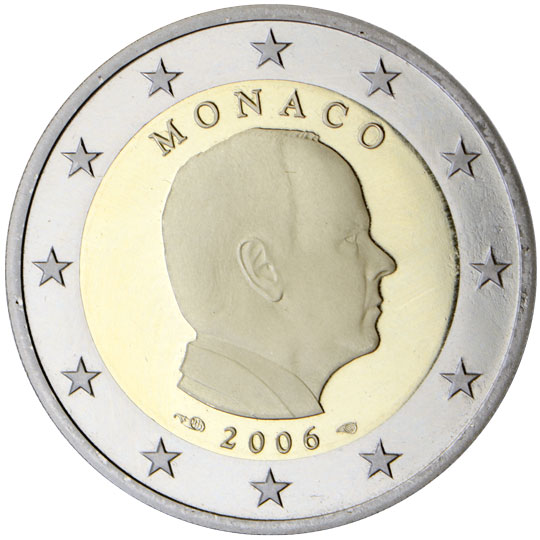 |
The second series Edge lettering of the €2 coin: 2**, repeated six times, alternately upright and inverted. HSH Prince Albert’s monogram is depicted on the 10, 20 and 50 cent coins. The coat of arms of the Sovereign Princes of Monaco is the main feature of the design on the 1, 2 and 5 cent coins. Design by: Joaquin Jimenez |
| NETHERLANDS | |
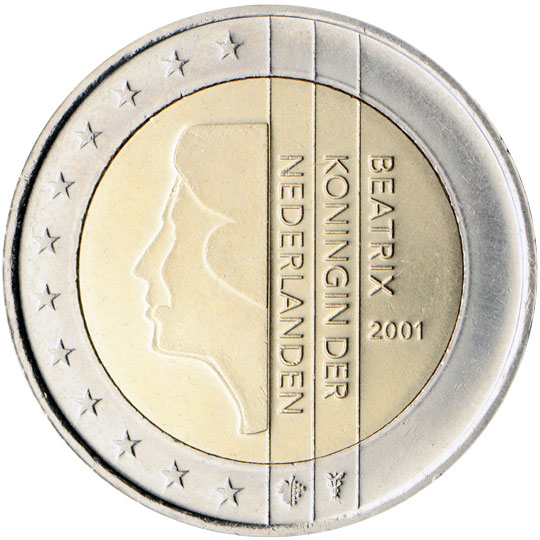 |
There are two series of Dutch coins in circulation. All are valid. The first series Edge lettering of the €2 coin: GOD * ZIJ * MET * ONS * (God be with us). The 50, 20, 10, 5, 2 and 1 cent coins show the portrait of Queen Beatrix with the inscription “Beatrix Koningin der Nederlanden” (Queen of the Netherlands). Design by: Bruno Ninaber van Eyben |
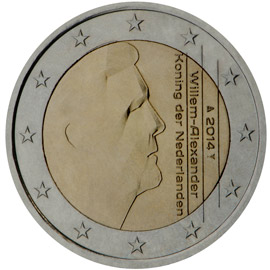 |
The second series Edge lettering of the €2 coin: GOD * ZIJ * MET * ONS * (God be with us). On the 50, 20, 10, 5, 2 and 1 cent coins, superimposed on an effigy of the King Willem-Alexander are the words "Willem-Alexander Koning der Nederlanden" (King of the Netherlands). The mint marks appear on either side of the name. Design by: Erwin Olaf |
| PORTUGAL | |
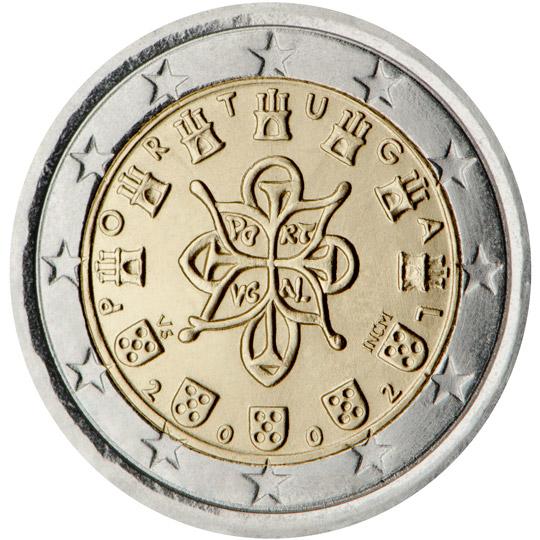 |
The €1 and €2 coins depict Portuguese castles and coats of arms set amid the European stars, symbolising dialogue, the exchange of values and the dynamics of the building of Europe. The centrepiece is the royal seal of 1144. Edge lettering of the €2 coin: five coats of arms and seven castles, all equally spaced. The 10, 20 and 50 cent coins depict Portuguese castles and coats of arms set amid the European stars, symbolising dialogue, the exchange of values and the dynamics of the building of Europe. The centrepiece is the royal seal of 1142. The 1, 2 and 5 cent coins depict Portuguese castles and coats of arms set amid the European stars, symbolising dialogue, the exchange of values and the dynamics of the building of Europe. The centrepiece is the royal seal of 1134, along with the inscription “Portugal”. Design by: Vítor Manuel Fernandes dos Santos |
| SAN MARINO | |
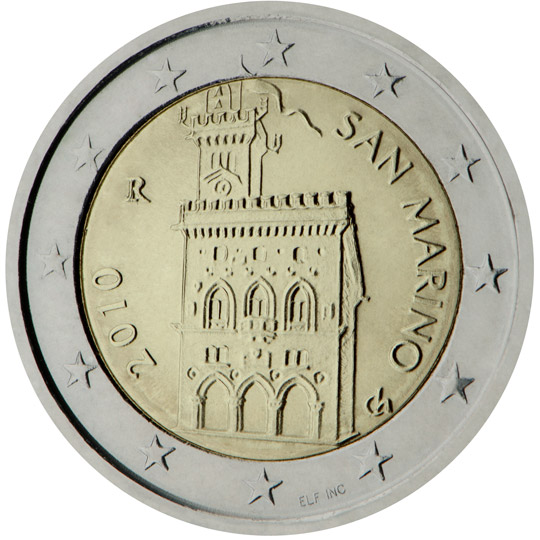 |
There are two series of San Marino coins in circulation. All are valid. The first series Edge lettering of the €2 coin: 2*, repeated six times, alternately upright and inverted. The Republic’s official coat of arms features on the €1 coin. The 50 cent coin shows the Three Towers of San Marino: Guaita, Cesta and Montale. Saint Marinus, based on a canvas of the Guercino school, is depicted on the 20 cent coin. The 10 cent coin features the Basilica of Saint Marinus. The 5 cent coin shows the First Tower of the Three Towers of San Marino, the Guaita Tower. The 2 cent coin shows the Statue of Liberty. The 1 cent coin shows the Third Tower of the Three Towers of San Marino, the Montale Tower. Design by: Frantisek Chochola |
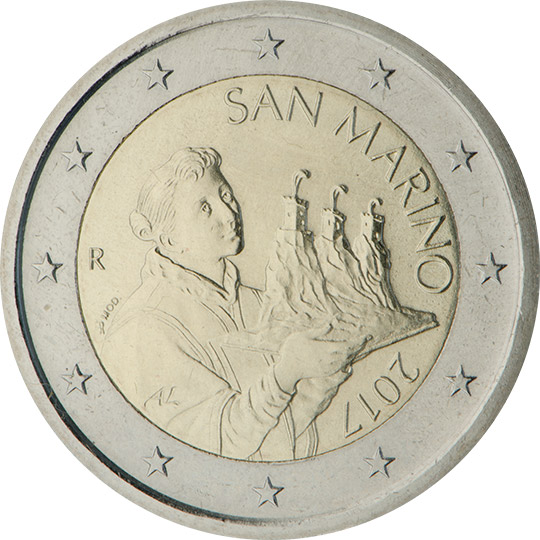 |
The second series Edge lettering of the €2 coin: 2*, repeated six times, alternately upright and inverted. The Second Tower of the Three Towers of San Marino, the Cesta Tower, features on the €1 coin. The 50 cent coin shows the portrait of Saint Marino, detail of a painting by Emilio Retrosi. Mount Titano with the three Towers is depicted on the 20 cent coin. The 10 cent coin features the Church of St Francis. The 5 cent coin shows the Church of St Quirinus. The 2 cent coin shows the City Gate. The €1 coin shows the official coat of arms of the Republic of San Marino. Design by: Frantisek Chochola |
| SLOVAKIA | |
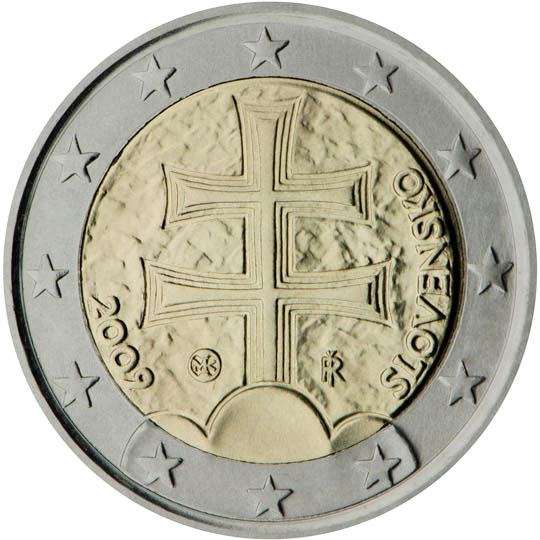 |
The €1 and €2 coins depict the motif of a double cross on three hills, as featured in the national emblem of Slovakia. The 10, 20 and 50 cent coins show Bratislava castle and the national emblem of Slovakia. The 1, 2 and 5 cent coins feature the Tatras and the peak, Kriváň, a symbol of the sovereignty of the Slovak nation, and the national emblem of Slovakia. Design by: Drahomír Zobek (1, 2 and 5 cent), Ján Černaj and Pavol Károly (10, 20 and 50 cent), Ivan Řehák (€1 and €2) |
| SLOVENIA | |
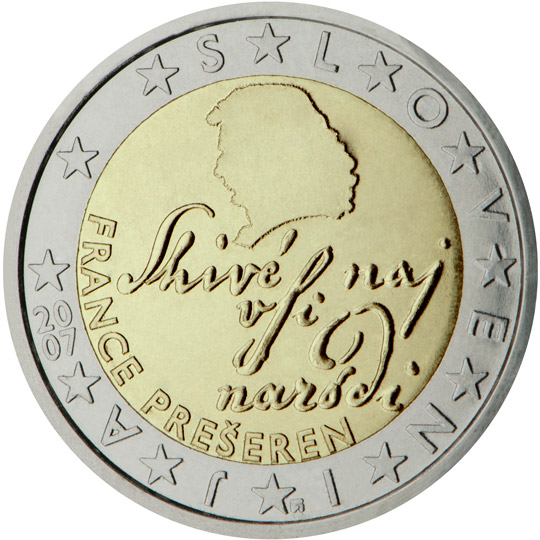 |
The €2 coin shows the poet France Prešeren and the inscription "Shivé naj vsi naródi" (God’s blessing on all nations) − a line taken from his poem "Zdravljica" which is also used in the country’s national anthem. Edge lettering of the €2 coin: SLOVENIJA followed by an engraved dot. The €1 coin bears a portrait of Primož Trubar, author of the first book printed in Slovene. The Triglav mountain is depicted on the 50 cent coin. Lipizzaner horses are depicted on the 20 cent coin. The 10 cent coin features architect Jože Plečnik’s unrealised plan for the Slovenian Parliament. The 5 cent coin depicts a sower. The Sovereign Enthronement Stone features on the 2 cent coin. The 1 cent coin bears the image of a stork. Design by: Miljenko Licul and assistants Maja Licul and Janez Boljka |
| SPAIN | |
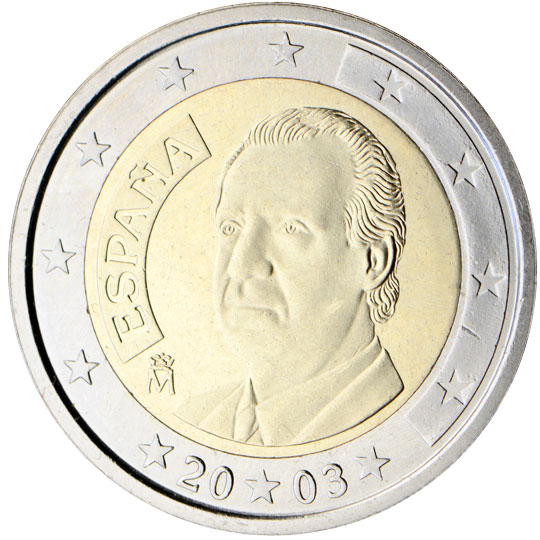 |
There are three series of Spanish coins in circulation. All are valid. The first series The portrait of Miguel de Cervantes, the father of Spanish literature, is shown on the 10, 20 and 50 cent coins, reflecting the universality of the man and his work. The 1, 2 and 5 cent coins picture the cathedral in the city of Santiago de Compostela, a jewel of Spanish Romanesque architecture and one of the most famous pilgrimage destinations in the world. They show the monumental facade of the Obradoiro, a splendid example of Spanish baroque construction, started in 1667 by Jose del Toro and Domingo de Andrade. It was finished in the 18th century by Fernando Casas y Novoa. |
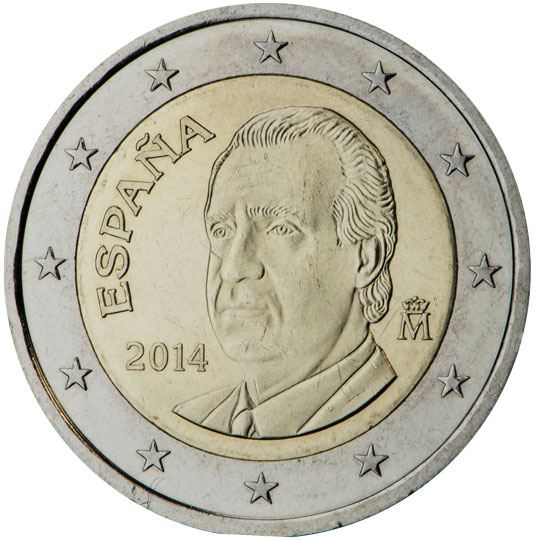 |
The second series |
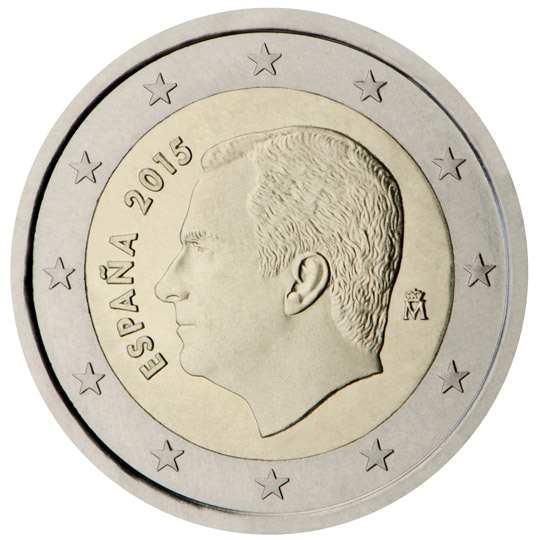 |
The third series Design by: Garcilaso Rollán (1, 2 and 5 cent), Begoña Castellanos Garcia (10, 20 and 50 cent), Luis José Diaz (€1 and €2) |
| VATICAN CITY | |
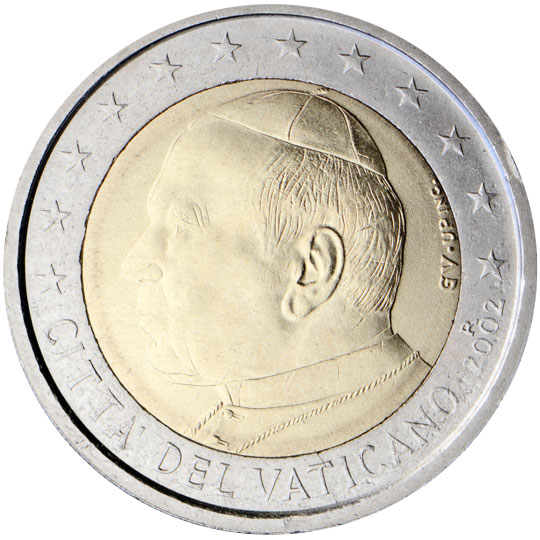 |
There are five series of Vatican City coins in circulation. All are valid. The first series Edge lettering of the €2 coin: 12 stars of the European flag, the words "CITTÀ DEL VATICANO", the year of issuance and the mintmark "R". Design by: Guido Veroi |
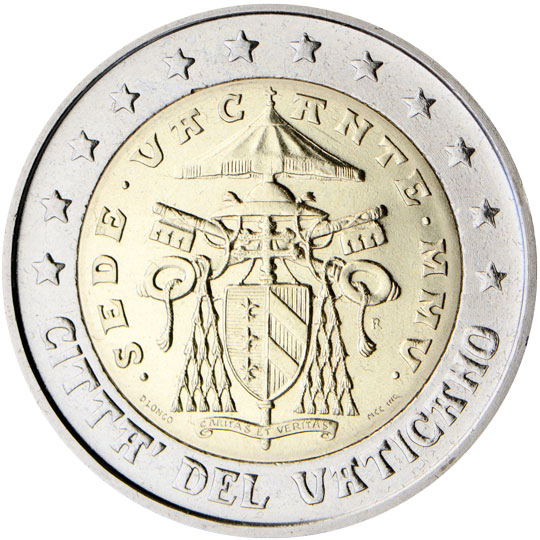 |
The second series Edge lettering of the €2 coin: 12 stars of the European flag, the words "CITTÀ DEL VATICANO", the year of issuance and the mintmark "R". Design by: Daniela Longo |
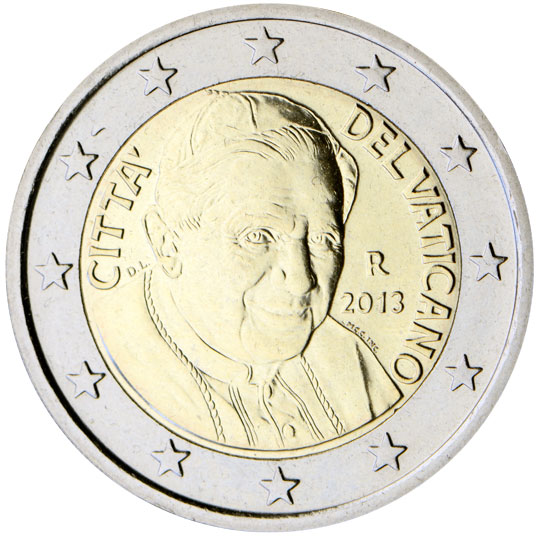 |
The third series Edge lettering of the €2 coin: 12 stars of the European flag, the words "CITTÀ DEL VATICANO", the year of issuance and the mintmark "R". Design by: Daniela Longo |
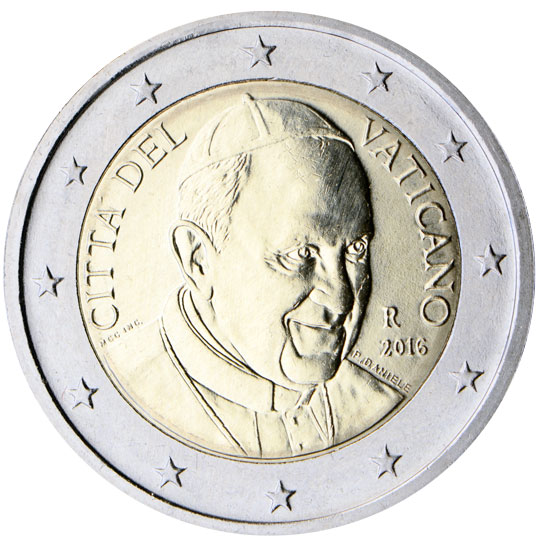 |
The fourth series Edge lettering of the €2 coin: 12 stars of the European flag, the words "CITTÀ DEL VATICANO", the year of issuance and the mintmark "R". Design by: Gabriella Titotto (1, 2 and 5 cent), Orietta Rossi (10, 20 and 50 cent), Patrizio Daniele (€1 and €2) |
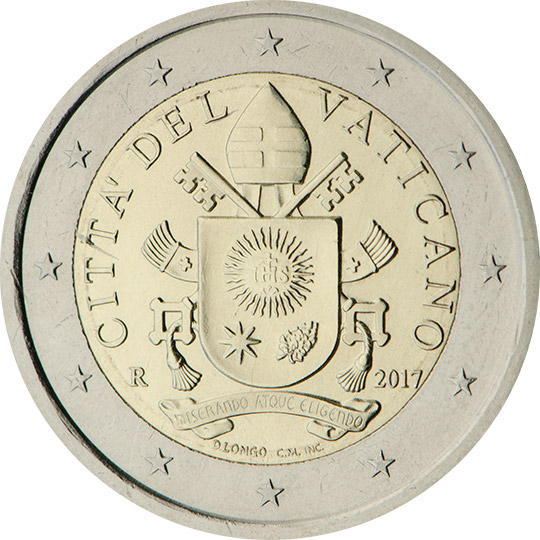 |
The fifth series Edge lettering of the €2 coin: 12 stars of the European flag, the words "CITTÀ DEL VATICANO", the year of issuance and the mintmark "R". Design by: Daniela Longo |
